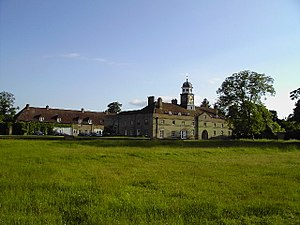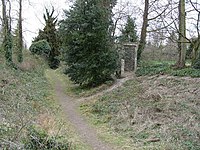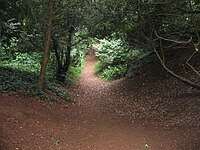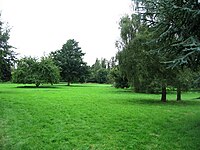Wandlebury Hill
| Wandlebury Hill | |||
| Cambridgeshire | |||
|---|---|---|---|
 The stable block at Wandlebury House | |||
| Range: | Gog Magog Hills | ||
| Summit: | 243 feet TL493533 52°9’28"N, -0°10’52"E | ||
Wandlebury Hill is a hill amongst the Gog Magog Hills in Cambridgeshire; the Gogs are a ridge of low chalk hills extending for several miles to the south-east of Cambridge, and Wandlebury Hill is where the hills begin, just south-east of the city, on the road to Babraham and north of Stapleford.
This is a popular spot for visitors to the Wandlebury Country Park and the Wandlebury Ring hill fort. Wandlebury House stands in the middle of the ring.
The underlying rock is present in a number of places on the hill. At 243 feet it is the same height as the nearby Little Trees Hill, although the latter is a more notable landmark.
The top stands in Wandlebury Country Park, a nature reserve owned by Cambridge Past Present and Future, formerly known as Cambridge Preservation Society.
Features of the hill
Wandlebury was already inhabited in the Bronze Age[1] and 2,500 years ago there was an Iron Age hill fort here known as Wandlebury Ring. This hill fort once had concentric ditches and earthen walls which were kept in place by wooden palisades. Although the fort has vanished, the ditch (the Ring) dug around the edge can clearly be seen and walked along, being 16 feet deep in places and offering an adventurous route along its edge. There is no evidence that it was ever used in hot defence.
Wandlebury House, home of among others, Francis Godolphin, stood within the Ring. The house has been demolished but the monumental stable block remains, now used for accommodation and as headquarters office of Cambridge Past Present Future. The grave of the Godolphin Barb horse, which died in 1753, can be seen under the archway. Maps and leaflets are available from the porch at all times and from a shed in car park on summer Sundays.
The tail of a crashed Second World War Wellington Bomber was visible wedged high in a beech tree within the estate, until it was dislodged by strong winds in the early 1990s.
The reserve, mainly beech woodlands and fields, is an excellent place for birdwatching and is a beautiful place for an early morning stroll. Banyard bird hide, overlooking Varley's Field, was completed in February 2012. Like Little Trees Hill, the summit is on public land and is accessible when sheep or Highland cattle are not in the field. Dogs must be on a lead everywhere in Wandlebury Country Park. It can be reached by walking across the field from post 3 of the nature trail. Virtually no climb is involved in the ascent, just a pleasant stroll through woodland.
Wandlebury Ring


Wandlebury Hill Fort, also known as the Wandlebury Ring, is an Iron Age hillfort located on Wandlebury Hill. Now a country park, it was the most important of three hillforts in the downs.
Of the three hillforts Cherry Hinton being one of them,[2] Wandlebury was the most important.[3] The site altitude is 203 feet above sea level.[4] There are at least two theories regarding why the Wandlebury Hill Fort was built on this site: it may have been chosen because of its tactical grounds, or because it would be the last fortress in a line which controlled the Thames-Stort-Cam Valley route.[5] Wandlebury overlooked the ancient Icknield Way.[3] The meeting point of the hundreds of Thriplow, Chilford, and Flendish is adjacent to Wandlebury.[4]
Historical analysis
Wandlebury dates to the Marnian Epoch's second immigration.[2] The first hillfort was constructed in about 400 BC, consisting of "a substantial outer ditch and an inner rampart bank of chalk rubble and soil, enclosing a circular area of about 6 ha."[6] A second ditch and bank circuit was added on the inner side of the first rampart in the 1st century BC, and a low counterscarp bank added around the perimeter. The inner ring had a wooden palisading to deter invaders.[7]
Wandlebury was a border settlement.[2] There is evidence that it was occupied by the Romans.[6] The Romans built a road from Worts Causeway to Wandlebury.[8] Two pottery sequence have been found establishing two separate construction phases.[9] It may have been inhabited into the 1st century AD.[9] It was later named Wendlesbiri (meaning, "Wændal's fort")[2] in the Anglo-Saxon period and used as a Hundred moot meeting place. Sir Thomas Malory mentions a Wandesborow Castle in Le Morte Darthur (1470), probably referring to the Wandelbury Ring.[10]
The site has undergone considerable change since the 17th century.[11] When a house, garden and racing stable was built for King James II within the boundaries of the old fort in 1685, the inner rampart and ditch were levelled.[6] The mansion was later owned by Lord Godolphin and demolished in 1956, but the stable remains.Cite error: Invalid parameter in <ref> tag The site is now a country park.[3]
Legend and literature

The fort and surrounding hills are shrouded in legends. Gervase of Tilbury said in his Otia Imperialia of 1214: "In England, on the borders of the diocese of Ely, there is a town called Cantabrica, just outside of which is a place known as Wandlebria, from the fact that the Wandeli, when ravaging Britain and savagely putting to death the Christians, placed their camp there, Now, on the hill-top where they pitched their tents, is a level space ringed with entenchments with a single point of entry, like a gate.
A very ancient legend exists, preserved in popular tradition, that if a warrior enters this level space at dead of nigh by moonlight and calls out 'Knight to knight, come forth', he will at once be faced by a warrior armed for fight, who charging horse against horse, will either dismount his adversary or himself be dismounted."[10] A knight named Osbert once tested the story and legend has it that he appeared in full armour and defeated the knight who appeared to him but was wounded in the thigh by his opponents' javelin on departing.[10] This is mentioned in Sir Walter Scott's 1808 poem Marmion featuring King Alexander III jousting with a goblin knight.[10] Another poet wrote a poem named Wandlebury Ring, a "nostalgic memory of a happy day in childhood spent at Wandlebury Ring with his family" and in memory of his father.[12]
Outside links
| ("Wikimedia Commons" has material about Wandlebury Ring) |
- The Prehistoric Society on Bronze Age ritual activity
- Cambridge Past and Present (formerly the Cambridge Preservation Society)'s page about Wandlebury
References
- ↑ Over the Hills to Cherry Hinton, H. C. Coppock, 1984, Plumridge, Linton, Cambridge, p.14.
- ↑ 2.0 2.1 2.2 2.3 Lethbridge, Thomas Charles (1957). Gogmagog: the Buried Gods. Taylor & Francis. pp. 69–. GGKEY:65Q7BXY9A71. http://books.google.com/books?id=iEgVAAAAIAAJ&pg=PA69. Retrieved 21 July 2012.
- ↑ 3.0 3.1 3.2 Boyd, Stephanie (16 January 2005). The Story Of Cambridge. Cambridge University Press. p. 9. ISBN 978-0-521-62897-6. http://books.google.com/books?id=513tnau__fgC&pg=PA7. Retrieved 20 July 2012.
- ↑ 4.0 4.1 Reynolds, Andrew (1 June 2009). Anglo-Saxon Deviant Burial Customs. Oxford University Press. pp. 111–. ISBN 978-0-19-954455-4. http://books.google.com/books?id=vIbwXW6MPRoC&pg=PA111. Retrieved 21 July 2012.
- ↑ Fox, Sir Cyril Fred (1923). The Archaeology of the Cambridge Region. CUP Archive. pp. 139–. GGKEY:6CH6DA0FZWK. http://books.google.com/books?id=CRo9AAAAIAAJ&pg=PA139. Retrieved 21 July 2012.
- ↑ 6.0 6.1 6.2 "Wandlebury Hill Fort - Myths and Legends". Cambridge Past, Present & Future. http://cambridgeppf.org/wandlebury-myths-and-legends.shtml. Retrieved 20 July 2012.
- ↑ Rouse, Mike (1 April 1974). A View into Cambridgeshire. T. Dalton. p. 15. http://books.google.com/books?id=PX0fAQAAMAAJ. Retrieved 20 July 2012.
- ↑ Palacios, Julian (12 October 2010). Syd Barrett and Pink Floyd: Dark Globe. Plexus. p. 25. ISBN 978-0-85965-431-9. http://books.google.com/books?id=DvgH58uEPFAC&pg=PA25. Retrieved 20 July 2012.
- ↑ 9.0 9.1 Cunliffe, Barry W. (10 January 2005). Iron Age Communities in Britain: An Account of England, Scotland and Wales from the Seventh Century BC Until the Roman Conquest. Psychology Press. pp. 102–. ISBN 978-0-415-34779-2. http://books.google.com/books?id=3lkEgdtOvGEC&pg=PA102. Retrieved 21 July 2012.
- ↑ 10.0 10.1 10.2 10.3 Chainey, Graham (27 July 1995). A Literary History of Cambridge. CUP Archive. pp. 4–5. ISBN 978-0-521-47681-2. http://books.google.com/books?id=29E8AAAAIAAJ&pg=PA4. Retrieved 20 July 2012.
- ↑ Garrett, Martin (2004). Cambridge: A Cultural and Literary History. Signal Books. p. 2. ISBN 978-1-902669-79-3. http://books.google.com/books?id=2-gCqtMfi-YC&pg=PA2. Retrieved 20 July 2012.
- ↑ National Association of Teachers of Singing (U.S.) (2006). Journal of singing: the official journal of the National Association of Teachers of Singing. The Association. http://books.google.com/books?id=AhAKAQAAMAAJ. Retrieved 20 July 2012.
